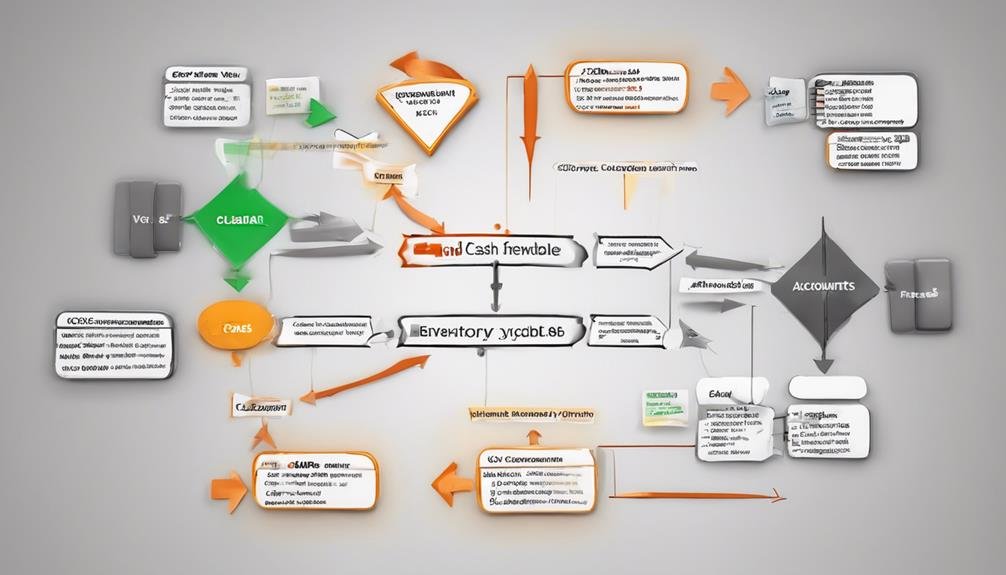Cash Conversion Cycle (CCC): What Is It, and How Is It Calculated?
The Cash Conversion Cycle (CCC) assesses how effectively a company manages its cash flow by analyzing inventory turnover, accounts receivable, and accounts payable. It calculates the time taken to convert resources into cash inflows and outflows. CCC highlights financial efficiency and operational effectiveness, with a lower CCC indicating superior cash flow optimization. Essential for identifying areas for improvement, it aids in monitoring trends over time. Components of the formula, including inventory turnover and receivables/payables, reflect operational efficiency. Understanding CCC's impact on financial metrics and operational efficiency is vital for better liquidity management. For more insights into CCC's applications and benefits, explore further.
Key Takeaways
- CCC evaluates cash flow efficiency in a business.
- It combines inventory, receivables, and payables turnover rates.
- Lower CCC signifies effective cash flow optimization.
- Key for monitoring trends and identifying improvements.
- Reflects operational efficiency and financial health.
Understanding Cash Conversion Cycle (CCC)
The Cash Conversion Cycle (CCC) is an important financial metric that evaluates the efficiency of a company's cash flow management through the analysis of its inventory, accounts receivable, and accounts payable turnover rates.
Cash flow optimization is essential for ensuring a company can meet its financial obligations while maximizing available cash for growth and investment. Operational efficiency plays a significant role in determining how effectively a company can convert its investments in inventory into cash inflows from sales.
By streamlining inventory management, improving accounts receivable collection processes, and optimizing accounts payable timelines, companies can reduce their CCC, indicating a more efficient use of resources and better financial health.
Monitoring and enhancing operational efficiency are key strategies for maintaining a healthy CCC and overall financial performance.
Significance of CCC Calculation
Analyzing the Cash Conversion Cycle (CCC) calculation provides essential insights into a company's financial efficiency and operational effectiveness. The CCC is an important metric for evaluating operational efficiency and performance.
A lower CCC signifies effective cash flow optimization and strategy implementation, indicating that the company is efficiently managing its short-term assets and liabilities.
Monitoring CCC trends over time is crucial for identifying areas of improvement in inventory management, receivables collection, and payables management.
Application of CCC in Business
Utilizing the Cash Conversion Cycle (CCC) in business operations offers a strategic approach to optimizing cash flow efficiency and enhancing financial performance.
- CCC aids in evaluating operational efficiency by analyzing the time taken to convert inventory investments into cash flows.
- Essential inventory management is vital for reducing the CCC, ensuring swift inventory turnover and minimal cash tied up in stock.
- Effective management of accounts receivable and payables impacts the CCC positively, emphasizing the importance of optimizing these processes.
- Industries heavily reliant on inventory management, like retail and manufacturing, benefit greatly from utilizing CCC to streamline operations and improve overall financial health.
Components of CCC Formula
An in-depth examination of the components within the Cash Conversion Cycle (CCC) formula reveals the intricate interplay of inventory turnover, accounts receivable, and accounts payable in evaluating a company's operational efficiency.
Inventory turnover is a critical component as it indicates how quickly a company sells and replaces its inventory. Faster turnover typically leads to a shorter CCC.
Accounts receivable represents the time it takes for a company to collect payment from its customers, impacting the cash flow cycle. On the other hand, accounts payable reflect the period in which a company pays its suppliers, influencing the outflow of cash.
Efficient management of these payment cycles is essential for optimizing the CCC and enhancing overall financial performance.
Relationship Between CCC and Financial Metrics
The intricate interplay of inventory turnover, accounts receivable, and accounts payable within the Cash Conversion Cycle (CCC) formula highlights the significant relationship between CCC and key financial metrics.
- Financial Ratios: CCC influences financial ratios like return on assets (ROA) and return on equity (ROE) by reflecting the efficiency of a company's working capital management.
- Profit Margins: A shorter CCC can lead to improved profit margins as it indicates quicker cash cycles, allowing for more effective use of capital.
- Operational Efficiency: CCC directly impacts operational efficiency, influencing the overall financial health of a company.
- Liquidity Management: Efficient management of CCC ensures better liquidity, which is crucial for sustaining business operations and growth.
Insights From Cash Conversion Cycle
Efficient management of the Cash Conversion Cycle provides valuable insights into a company's financial operations and overall performance. By analyzing the CCC, businesses can identify areas for operational improvements and compare their performance against industry benchmarks.
Maintaining a shorter CCC can offer a competitive advantage by optimizing cash flow and enhancing liquidity. Companies with a streamlined CCC can benefit from quicker cash cycles, improved working capital efficiency, and better financial health.
Monitoring CCC trends over time is essential for identifying opportunities to enhance operational efficiency and strengthen the company's position within its industry. Through effective management of the Cash Conversion Cycle, businesses can aim for financial stability and sustainable growth.
Managing Cash Flow Efficiency
Managing cash flow effectively involves optimizing the movement of funds within a company to enhance financial viability and operational stability.
- Improving Collections: Timely collection of accounts receivable minimizes cash tied up in outstanding payments.
- Inventory Optimization: Efficient inventory management reduces storage costs and enhances cash flow.
- Streamlining Payables: Negotiating favorable payment terms with suppliers can improve cash flow.
- Cash Flow Forecasting: Accurate forecasting helps in anticipating cash needs and optimizing cash reserves.
Importance of CCC in Financial Health
Optimizing the Cash Conversion Cycle (CCC) is essential to evaluating a company's financial health and operational efficiency. The CCC reflects how well a company manages its cash flow optimization, which directly impacts its liquidity and overall financial stability.
By efficiently managing the time it takes to convert investments in inventory into cash flows, a company can improve its operational efficiency and guarantee smoother financial operations. A shorter CCC indicates better operational efficiency, as it signifies that the company is effectively managing its inventory, accounts receivable, and accounts payable.
Monitoring CCC trends over time is vital for identifying areas where operational improvements can be made to enhance the company's financial health and sustainability in the long term.
Conclusion
In the intricate web of financial analysis, the Cash Conversion Cycle (CCC) emerges as a symbolic compass guiding businesses through the labyrinth of operational efficiency and financial stability.
By unraveling the threads of inventory turnover, receivables collection, and payables management, the CCC reveals the hidden pathways to accessing liquidity and optimizing cash flow dynamics.
Embracing the CCC as a beacon of insight, businesses can navigate the turbulent waters of financial management with clarity and precision.







